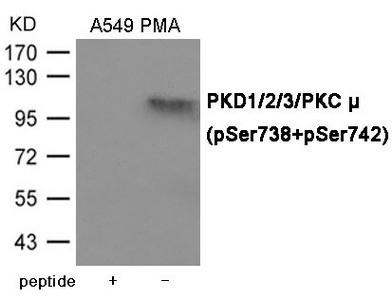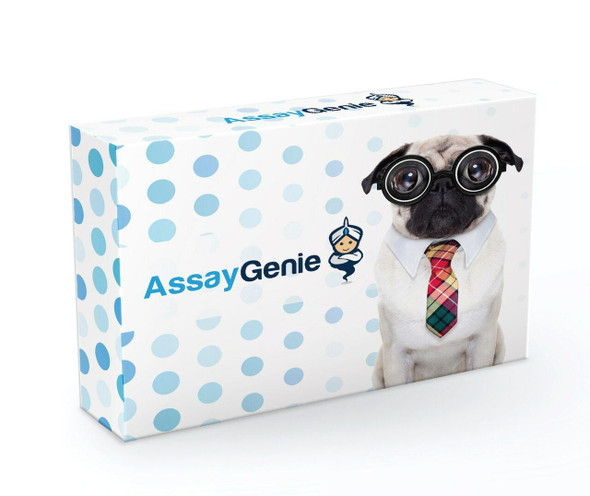Description
| Antibody Name: | Phospho-PRKD1/PRKD2/PRKD3 (Ser738/742) Antibody (PACO23993) |
| Antibody SKU: | PACO23993 |
| Size: | 100ul |
| Host Species: | Rabbit |
| Tested Applications: | ELISA, WB |
| Recommended Dilutions: | ELISA:1:2000-1:10000, WB:1:500-1:1000 |
| Species Reactivity: | Human, Mouse, Rat |
| Immunogen: | Peptide sequence around phosphorylation site of Serine738/Serine 742(E-K-S(p)-F-R-R-S(p)-V-V) derived from Human PKD1/2/3/PKCµ. |
| Form: | Liquid |
| Storage Buffer: | Supplied at 1.0mg/mL in phosphate buffered saline (without Mg2+ and Ca2+), pH 7.4, 150mM NaCl, 0.02% sodium azide and 50% glycerol. |
| Purification Method: | Antibodies were produced by immunizing rabbits with synthetic phosphopeptide and KLH conjugates. Antibodies were purified by affinity-chromatography using epitope-specific phosphopeptide. Non-phospho specific antibodies were removed by chromatogramphy using non-phosphopeptide. |
| Clonality: | Polyclonal |
| Isotype: | IgG |
| Conjugate: | Non-conjugated |
 | Western blot analysis of extracts from A549 cells with PMA using PKD1/2/3/PKC ? (Phospho-Ser738+Ser742) Antibody.The lane on the left is treated with the antigen-specific peptide. |
| Background: | Serine/threonine-protein kinase that converts transient diacylglycerol (DAG) signals into prolonged physiological effects downstream of PKC, and is involved in the regulation of MAPK8/JNK1 and Ras signaling, Golgi membrane integrity and trafficking, cell survival through NF-kappa-B activation, cell migration, cell differentiation by mediating HDAC7 nuclear export, cell proliferation via MAPK1/3 (ERK1/2) signaling, and plays a role in cardiac hypertrophy, VEGFA-induced angiogenesis, genotoxic-induced apoptosis and flagellin-stimulated inflammatory response. Phosphorylates the epidermal growth factor receptor (EGFR) on dual threonine residues, which leads to the suppression of epidermal growth factor (EGF)-induced MAPK8/JNK1 activation and subsequent JUN phosphorylation. Phosphorylates RIN1, inducing RIN1 binding to 14-3-3 proteins YWHAB, YWHAE and YWHAZ and increased competition with RAF1 for binding to GTP-bound form of Ras proteins (NRAS, HRAS and KRAS). Acts downstream of the heterotrimeric G-protein beta/gamma-subunit complex to maintain the structural integrity of the Golgi membranes, and is required for protein transport along the secretory pathway. In the trans-Golgi network (TGN), regulates the fission of transport vesicles that are on their way to the plasma membrane. May act by activating the lipid kinase phosphatidylinositol 4-kinase beta (PI4KB) at the TGN for the local synthesis of phosphorylated inositol lipids, which induces a sequential production of DAG, phosphatidic acid (PA) and lyso-PA (LPA) that are necessary for membrane fission and generation of specific transport carriers to the cell surface. Under oxidative stress, is phosphorylated at Tyr-463 via SRC-ABL1 and contributes to cell survival by activating IKK complex and subsequent nuclear translocation and activation of NFKB1. Involved in cell migration by regulating integrin alpha-5/beta-3 recycling and promoting its recruitment in newly forming focal adhesion. In osteoblast differentiation, mediates the bone morphogenic protein 2 (BMP2)-induced nuclear export of HDAC7, which results in the inhibition of HDAC7 transcriptional repression of RUNX2. In neurons, plays an important role in neuronal polarity by regulating the biogenesis of TGN-derived dendritic vesicles, and is involved in the maintenance of dendritic arborization and Golgi structure in hippocampal cells. May potentiate mitogenesis induced by the neuropeptide bombesin or vasopressin by mediating an increase in the duration of MAPK1/3 (ERK1/2) signaling, which leads to accumulation of immediate-early gene products including FOS that stimulate cell cycle progression. Plays an important role in the proliferative response induced by low calcium in keratinocytes, through sustained activation of MAPK1/3 (ERK1/2) pathway. Downstream of novel PKCµignaling, plays a role in cardiac hypertrophy by phosphorylating HDAC5, which in turn triggers XPO1/CRM1-dependent nuclear export of HDAC5, MEF2A transcriptional activation and induction of downstream target genes that promote myocyte hypertrophy and pathological cardiac remodeling. Mediates cardiac troponin I (TNNI3) phosphorylation at the PKA sites, which results in reduced myofilament calcium sensitivity, and accelerated crossbridge cycling kinetics. The PRKD1-HDAC5 pathway is also involved in angiogenesis by mediating VEGFA-induced specific subset of gene expression, cell migration, and tube formation. In response to VEGFA, is necessary and required for HDAC7 phosphorylation which induces HDAC7 nuclear export and endothelial cell proliferation and migration. During apoptosis induced by cytarabine and other genotoxic agents, PRKD1 is cleaved by caspase-3 at Asp-378, resulting in activation of its kinase function and increased sensitivity of cells to the cytotoxic effects of genotoxic agents. In epithelial cells, is required for transducing flagellin-stimulated inflammatory responses by binding and phosphorylating TLR5, which contributes to MAPK14/p38 activation and production of inflammatory cytokines. May play a role in inflammatory response by mediating activation of NF-kappa-B. May be involved in pain transmission by directly modulating TRPV1 receptor. |
| Synonyms: | PKD, PKCM, PRKCM, PKC-MU |
| UniProt Protein Function: | PRKD1: a CAMK kinase of the PKD family. Cleavage by caspase-3 following DNA damage activates it and alters its subcellular localization. Sensitizes cells to apoptosis induced by genotoxic stress. Its cleavage is blocked in cells that over-express the anti-apoptotic Bcl-x(L) protein. Expression of a caspase-resistant mutant partially inhibits DNA damage-induced apoptosis. Its activation by TLR ligands is dependent on MyD88, IRAK4 and -1, but not TRAF6. Essential for MyD88-dependent proinflammatory immune responses. Activated by diacylglycerol and phorbol esters. Binds to the trans-Golgi network and regulates the fission of transport carriers specifically destined to the cell surface. Colocalizes with F-actin at peripheral F-actin-rich structures in membrane ruffles at the edge of lamellipodia in cervical carcinoma cells. Substrates reportedly include critical regulatory proteins including CREB, SSH1L, CTNNB1, HDACs 5 and 7, PKD1, HPK1, MARK2, PIP5K2A, PPP1R14A |
| UniProt Protein Details: | Protein type:EC 2.7.11.13; Protein kinase, CAMK; Motility/polarity/chemotaxis; Autophagy; Protein kinase, Ser/Thr (non-receptor); Kinase, protein; CAMK group; PKD family Chromosomal Location of Human Ortholog: 14q11 Cellular Component: cytoplasm; cytosol; Golgi apparatus; integral to plasma membrane; plasma membrane; trans-Golgi network Molecular Function:identical protein binding; kinase activity; protein binding; protein kinase C activity; protein serine/threonine kinase activity Biological Process: activation of CREB transcription factor; activation of NF-kappaB transcription factor; cell proliferation; Golgi organization and biogenesis; Golgi vesicle transport; integrin-mediated signaling pathway; negative regulation of endocytosis; peptidyl-serine phosphorylation; positive regulation of angiogenesis; positive regulation of blood vessel endothelial cell migration; positive regulation of endothelial cell proliferation; positive regulation of I-kappaB kinase/NF-kappaB cascade; positive regulation of osteoblast differentiation; positive regulation of peptidyl-serine phosphorylation; positive regulation of transcription from RNA polymerase II promoter; protein amino acid autophosphorylation; protein amino acid phosphorylation; Ras protein signal transduction; regulation of protein stability; signal transduction; sphingolipid biosynthetic process; vascular endothelial growth factor receptor signaling pathway |
| NCBI Summary: | PRKD1 is a serine/threonine kinase that regulates a variety of cellular functions, including membrane receptor signaling, transport at the Golgi, protection from oxidative stress at the mitochondria, gene transcription, and regulation of cell shape, motility, and adhesion (summary by Eiseler et al., 2009 [PubMed 19329994]).[supplied by OMIM, Nov 2010] |
| UniProt Code: | Q15139 |
| NCBI GenInfo Identifier: | 209572639 |
| NCBI Gene ID: | 5587 |
| NCBI Accession: | Q15139.2 |
| UniProt Secondary Accession: | Q15139,A6NL64, B2RAF6, |
| UniProt Related Accession: | Q15139 |
| Molecular Weight: | 101,704 Da |
| NCBI Full Name: | Serine/threonine-protein kinase D1 |
| NCBI Synonym Full Names: | protein kinase D1 |
| NCBI Official Symbol: | PRKD1 |
| NCBI Official Synonym Symbols: | PKD; PKCM; PRKCM; PKC-MU |
| NCBI Protein Information: | serine/threonine-protein kinase D1 |
| UniProt Protein Name: | Serine/threonine-protein kinase D1 |
| UniProt Synonym Protein Names: | Protein kinase C mu type; Protein kinase D; nPKC-D1; nPKC-mu |
| Protein Family: | Serine/threonine-protein kinase |
| UniProt Gene Name: | PRKD1 |
| UniProt Entry Name: | KPCD1_HUMAN |
| Antibodies | ELISA Kits |
| Phospho-PRKD1/PRKD2/PRKD3 (S738/S742) Antibody (PACO03012) | PKD1/2/3 Colorimetric Cell-Based ELISA Kit |
| PRKD1/PRKD2/PRKD3 Antibody (PACO04738) |
| Secondary Antibody |
| Anti-HRP Goat Anti-Rabbit IgG (H+L) Antibody (CABS014) |
| Recommended Products |
| Anti-FITC Goat Anti-Rabbit IgG (H+L) Antibody (CABS011) |
| Anti-HRP-conjugated Beta Actin Antibody (CABC028) |






